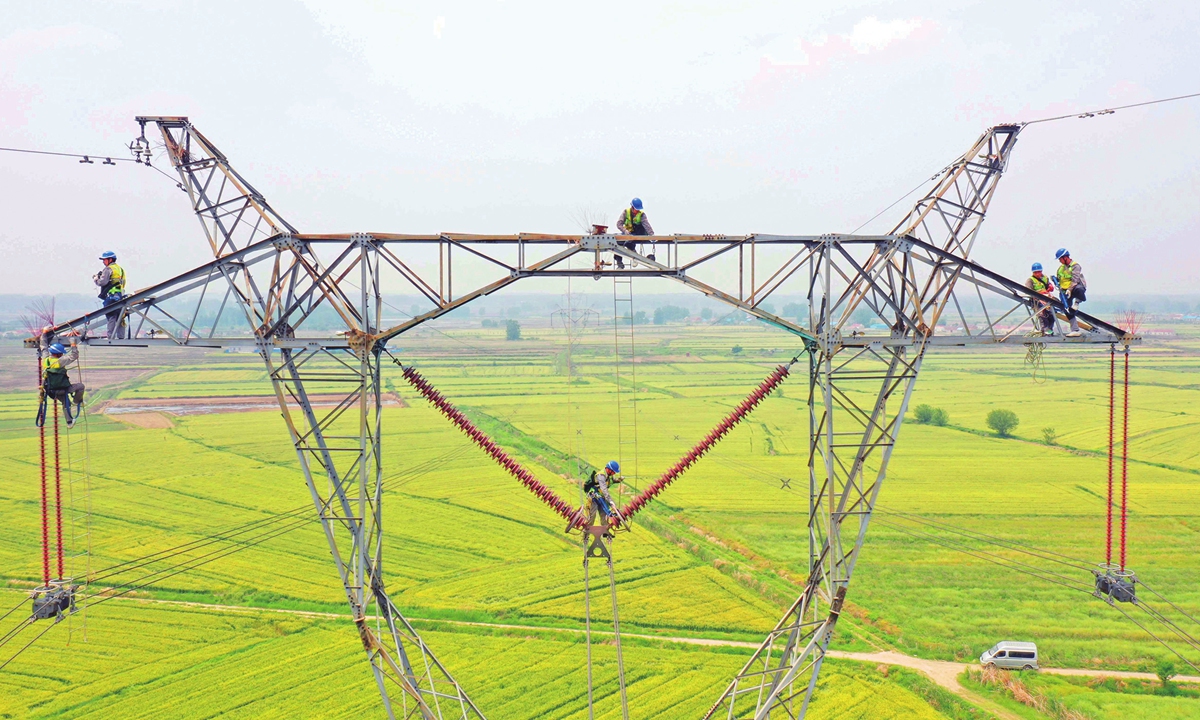Power plants ramp up operation for electricity consumption peak as temperatures soar

Workers conduct comprehensive maintenance of a 500-kilovolt transmission line in Chuzhou, East China's Anhui Province on May 28, 2023. With surging demand for electricity in summer, cities in China started seasonal power grid checks to ensure stable supply. Photo: cnsphoto
Power suppliers across China are ramping up to deal with an energy consumption peak that has come ahead of schedule amid a tight balance of supply, driven by hot weather in many areas.
Accompanied by surging residential demand for air conditioners, freezers and other appliances amid high temperatures, the peak of industrial electricity use has arrived. That means a continuous increase in the load on the power grid, experts said.
On Tuesday, the city of Guangzhou in South China's Guangdong Province initiated a level-III emergency weather response due to high temperatures.
In Panzhihua, an industrial hub in Southwest China's Sichuan Province, the local weather station on Tuesday issued this year's first high temperature red alert, the highest level, after readings in several parts of the region exceeded 40 C.
In response to surging demand, several major power plants are preparing to secure supply.
An employee with China Yangtze Power told the Global Times on Tuesday that first-quarter power use was up 18.4 percent year-on-year, and early preparations have been made to deal with the energy consumption peak.
Inner Mongolia Mengdian Huaneng Thermal Power Co is also gearing up. "Raw materials for power generation are being procured and supplied in a centralized way," a company employee said.
Power generation is expected to increase this summer in response to market demand, the person said.
Another large power supplier based in Beijing told the Global Times on Tuesday that it has noted rising demand and is actively securing the safety and stability of power supply.
The power load in southern China has been rising this month, with the five major power consumption provinces in South and Southwestern China - including Guangdong, Guangxi and Yunnan - all reporting an increase in demand.
The maximum load in Shenzhen, Guangdong Province has exceeded 19 million kilowatts, the highest this year, a year-on-year increase of 8.3 percent.
That figure was reached just a week after the load of China Southern Power Grid exceeded 200 million kilowatts for the first time this year, and a peak power consumption was reached ahead of schedule.
The National Energy Administration predicts that this year's maximum power load will show a greater increase than last year, and electricity supply will be in a tight balance.
The China Electricity Council predicts that this summer's highest electricity load will reach 1.37 billion kilowatts, up 80 million kilowatts compared with 2022.
Due to extreme temperatures, there may be some temporary local energy shortages, especially in Sichuan Province, which heavily relies on hydropower, Lin Boqiang, director of the China Center for Energy Economics Research at Xiamen University, told the Global Times on Tuesday.
That will require some adjustment of China's west-east power transmission program, which transmits electricity from the resource-rich southwest to energy-hungry regions in the east, the expert said.
Despite the surging demand, there won't be much impact on energy prices or supply, industry sources said.
The coal spot prices, the major cost for thermal generators, have been falling recently, which will help thermal power companies reduce costs and improve their performance, the Global Times learned.
"Electricity rates used to be contract-based, so they didn't change regardless of the cost of power… this year, the price system has changed to spot trading, which can mitigate the impact of coal price fluctuations," a manager at a power plant in Hohhot, Inner Mongolia, told the Global Times on Tuesday.
Lin said the overall impact of the summer heat should be limited nationwide. "Residential use of power only accounts for 17-18 percent of the total, compared with more than 70 percent for industrial use. Household use will get priority if it means the temporary suspension of supply to factories, and that will be enough," Lin said.


